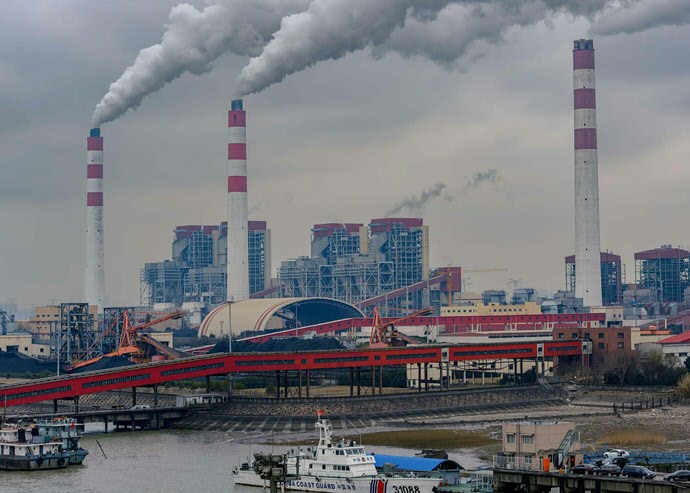Our insatiable appetite for consumption is driving up global CO2 emissions

Changes in the structure of international trade have had little effect on the growth in global CO2 emissions. That is the conclusion of Professor Erik Dietzenbacher, based on data from the World Input-Output Database (WIOD) for the period 1995-2008.
Text: Riepko Buikema
‘It’s a surprising conclusion, because world trade increased massively in that period. A quarter of global CO2 emissions are caused by goods that are produced elsewhere. In the past, therefore, this often gave the impression that you can prevent a lot of emissions by producing things locally. But that doesn’t prove to be the case. Shipping products from one place to another is not the cause of the marked increase in emissions. The main perpetrators are you and I, the ones who keep on buying more products. And what is more, our numbers are growing. So what counts most is what you eat and what you buy, rather than where you buy it.’
Black-headed spider monkey
A significant development in the last 20 years is the transformation of production networks from local or national chains to global ones. Raw and auxiliary materials (i.e. intermediate products) come from all corners of the world nowadays. ‘That chain goes all around the world. Everything that we do here as consumers has an almost immediate effect on the other side of the world, often without us knowing. I often use the example of the black-headed spider monkey, a monkey that is under serious threat of extinction because the rainforest is being destroyed for coffee plantations – perhaps for our morning cup of coffee here. We should become much more aware of the effects of our consumption patterns.’

Emerging countries vs. the rich West
Together with his colleague Iñaki Arto from the Basque Centre for Climate Change, Dietzenbacher looked at the geographical origin of the increasing CO2 emissions. ‘Fingers are nowadays often pointed at emerging countries such as Brazil, Russia, India, Indonesia and China. These countries have been growing like crazy, becoming increasingly rich and should now significantly reduce their emissions too. Their answer is, of course, that a large part of their emissions is due to rich countries. We rich westerners are the ones buying all those things that are produced in the emerging economies, after all.’
Exporting greenhouse gas emissions
That defence is partly correct, says Dietzenbacher, but this claim shouldn’t be exaggerated either. In another study, he shows that the effect that the Chinese counterargument is based on (‘look at yourselves: our emissions are caused by trying to meet your demand’) is overestimated by as much as 60%. ‘In the past, all Chinese emissions were ascribed to Chinese production as a whole. In our study, we distinguished between assembly (with relatively low emissions per produced dollar) and ‘normal’ production in China (with relatively high emissions per produced dollar). Given that about half of Chinese exports consist of assembly, you are making a serious error if you treat them as ‘normal’ production. With the aid of new data, we could show that China exports significantly fewer greenhouse gas emissions than was previously thought.’
Changing consumer culture
Nevertheless, there is a big difference between rich and poor countries in terms of the emissions that they cause. That is the main message from this research, says Dietzenbacher. ‘Poor countries generate emissions for consumption in rich countries. And that gap is actually widening rather than narrowing. Luckily, a slow but sure change in consumer culture is apparent in the West. For a long time, people thought it was up to the manufacturers to decide also on emissions, but consumers are increasingly forming a power bloc. They are forcing banks to look for ‘green’ businesses to give loans to and are, for instance, forcing Nike to take care of the use of child labour at their suppliers elsewhere in the production chain.’
Technological developments reduce emissions
The energy and environmental data in the WIOD will be updated in 2019. Dietzenbacher says that will give him the opportunity to update his calculations. ‘China will play an even more important role, but I don’t expect the general trend to suddenly be that different. We will also see that much has already been achieved by cleaning up production processes. The average emissions per production unit have decreased considerably over the last 15 years. There is still much more that can and should be done, but big steps have already been taken. You can see that in our research too. Without technological developments, emissions would have almost doubled as a result of population growth and the increasing consumption per person. Due to the gigantic technological improvements, the growth in emissions has proven relatively favourable. That effect has only continued after 2008, more so in poorer countries than in Europe and the US.’
| Last modified: | 01 February 2023 4.20 p.m. |
More news
-
20 November 2024
Gerard van den Berg appointed as member of the Academia Europaea
Professor Gerard van den Berg had been appointed as member of the Academia Europaea, the European Academy for Sciences, Humanities and Letters.
-
15 November 2024
Faculty of Economics and Business and Dutch Central Bank Announce New "Klaas Knot Lecture Series"
The Faculty of Economics and Business (FEB) of the University of Groningen and De Nederlandsche Bank (DNB) are pleased to announce the launch of the annual “Klaas Knot Lecture Series” on international economic policy.
-
21 October 2024
Liekuut | Full power grid? We need to use this scarce resource more efficiently
A lot has been said about the grid becoming congested, and efforts are being made to expand it. However, expanding the grid is not the most efficient solution, especially in the short term, says Machiel Mulder, Professor of Energy Economics at the...
